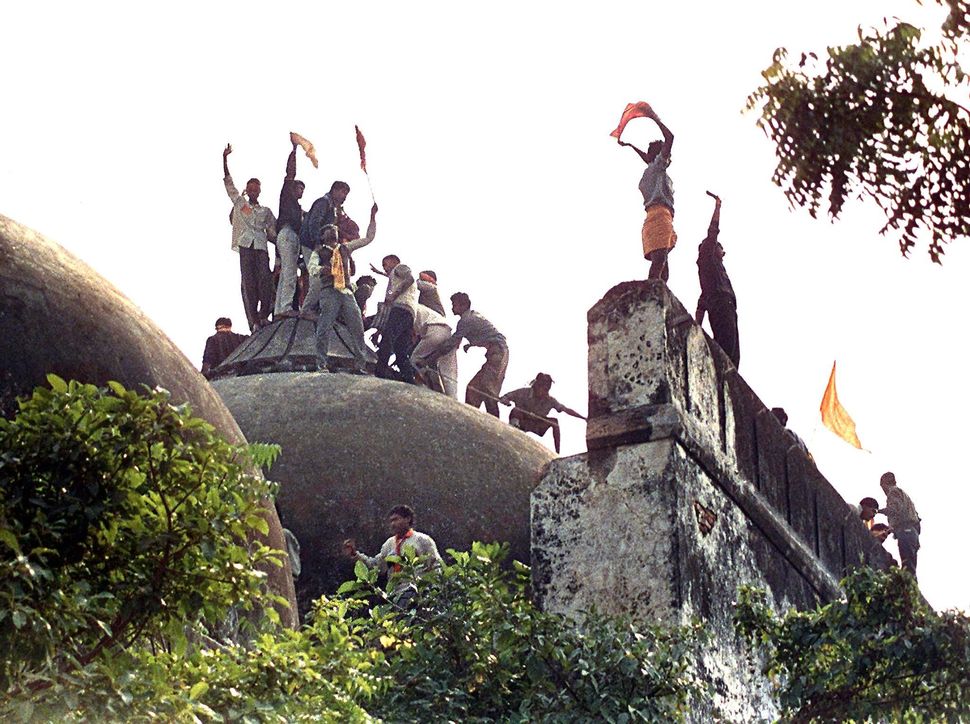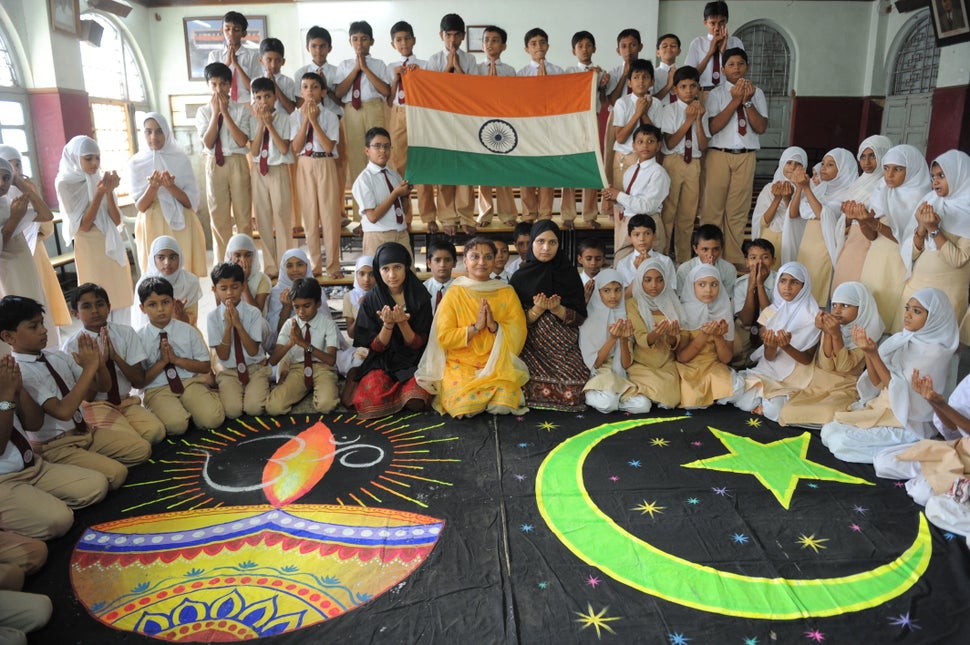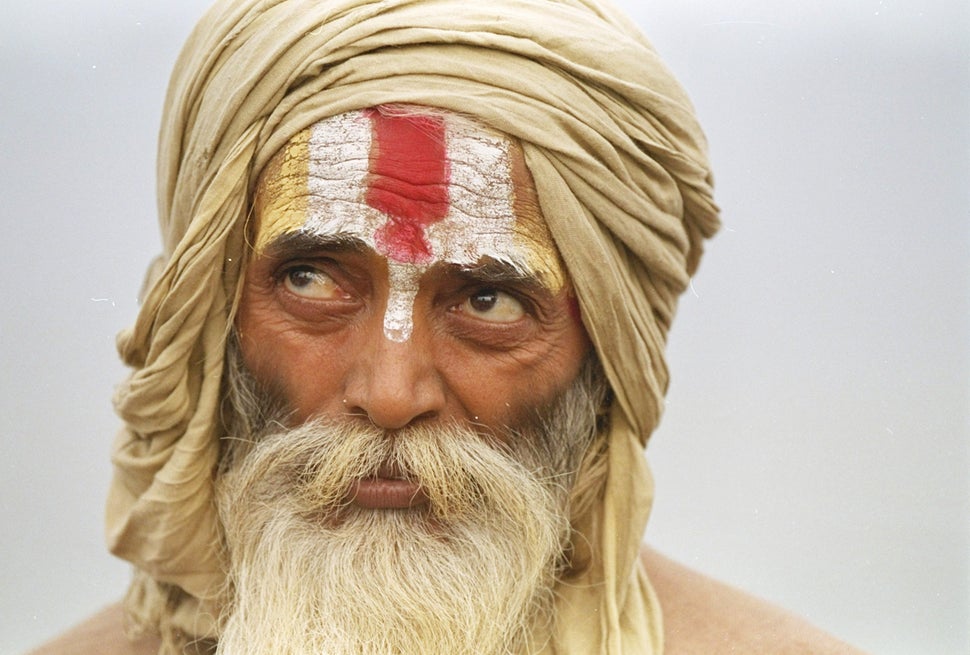
LUCKNOW, Uttar Pradesh — Why did the Archeological Survey of India (ASI) throw away animal bones discovered at the disputed Babri Masjid-Ramjanmabhumi site in Ayodhya?
This question was raised 17 years ago by archeologists appointed by the Allahabad High Court to observe the ASI-conducted excavation in 2003, at the behest of the Sunni Central Waqf Board, a party in the title suit.
“In front of our eyes, they were throwing basket full of bones. They were not recording or analysing them,” said Syed Ali Nadeem Rezavi, a professor of medieval Indian history and chairman of the Centre Of Advanced Studies, Department Of History, Aligarh Muslim University.
“They were just throwing them away because they were uncomfortable with this type of evidence,” said Rezavi, who was an observer at the excavation site.
Cooked animal bones, Rezavi says, were found in every layer that was excavated, which correspond to the time period from the 9th century to the present. It proved there was a never a temple where the Babri Masjid stood until it was demolished by Hindu karsevaks on 6 December, 1992, he said in a recent conversation with HuffPost India.
“Goats, cow and buffalo bones which are eaten, the cooked bones were found,” the historian said. “These were not recorded. There is no chapter in the full report, although we kept on protesting that they are not recording it.”
Rezavi says that cooked animal bones would never be found at the site of a Vaishnav temple devoted to Hindu god Ram. “The ASI said there was a temple under the mosque but we encountered beef bones on the site. Were these Brahmin meat eaters? Were they eating beef in the temple?” he asked.
“Were these Brahmin meat eaters? Were they eating beef in the temple?”

War of words
As the Supreme Court begins hearing the Babri Masjid-Ramjanmabhumi title suit, HuffPost India is revisiting aspects of the excavation that proved controversial and are yet to be addressed.
While it was argued that excavating the site unnecessary in a matter that is essentially a property dispute, the Allahabad High Court ordered the excavation. The ASI’s report concluded there were one or more temples, which were built from the 10th century onwards and stood there until the Babri Masjid was constructed in the 16th century. The report was refuted as erroneous and biased by observers and independent archaeologists. The Allahabad High Court, however, accepted the ASI’s findings.
“In our view, the conclusion drawn by the ASI in the project accomplished within an extraordinary brief period and with such excellent precision and perfection deserve commendation and appreciation instead of condemnation,” Justice Sudhir Agarwal said in the judgment.
Since then a war of words has ensued. Those who refute the ASI findings accuse its archaeologists of operating with a predetermined agenda to find evidence for a temple, given that the Bharatiya Janata Party (BJP) was in power in 2003. Those who support the ASI findings, on the one hand, says its critics were supporting the Sunni Muslim party in the title suit, but on the other hand, call them “Communist and Marxist archeologists.”
Rezavi, however, does not have a high opinion of the Sunni Central Waqf Board, the party he and other critics of the ASI report are supposedly favouring. “I’m neither Muslim, nor Sunni, but a Communist, who these people (Sunni Central Waqf Board) hate,” he said.
Another archeologist, K.K. Muhammad, says he was the only Muslim to have been part of the team led by B.B. Lal, a former director general of the ASI, who excavated around the Babri Masjid in 1976.
Muhammad, who retired as the ASI’s regional director for northern India in 2012, and frequently appears on television to defend the ASI findings, believes himself to be a “true liberal,” neither a foot soldier of the Hindu right nor a “extreme” Communist.
But even Muhammad cannot explain why animal bones were disposed off by the ASI. “I was not in the second excavation team. If the experts of the Waqf Board had objections, they should have immediately pointed it out. Then, it was for the court to take action against these people. But there were judges to supervise the excavation and everything was video-recorded,” he said.
Two archeologists, Supriya Verma and Jaya Menon, who were observes on behalf of the Sunni Central Waqf Board, did file a complaint against B.R. Mani, who was leading the excavation. But even after the Allahabad High Court ordered that he would no longer lead the excavation, observers said that Mani remained in-charge.
Mani, who was appointed director general of the national museum by the Modi government in 2016, did not respond to HuffPost India’s request for comment.
Muhammad said that Mani had told him that he and other ASI archeologists, involved in the 2003 excavation, have been “restrained” by the Supreme Court from speaking to the media while the title suit is sub judice.
Bones of contention
In 2003, following the Allahabad High Court’s judgment, the Aligarh Historians Society, led by Irfan Habib, an eminent historian of medieval history, published a critique of the ASI excavation and the Allahabad High Court’s reading of its report.
“The most sensational act of misconduct of the ASI officials has been that despite being reminded by the Bench of the need to preserve and record animal bones properly, they failed to do so,” the critique said.
“The bones of large and medium size animals (cattle, sheep and goats) would be a sure sign of animals being eaten or thrown away dead at the site, and, therefore, rule out a temple existing at the site at that time,” it said.
The critique noted that the ASI disregarded Allahabad High Court’s directions to record “the number and wherever possible size of bones and glazed wares.”
The day-to-day antiquities register maintained by the ASI, the report said, recorded bones being found in Period IV and VII, corresponding to the Early Medieval or Pre Sultanate period and End of the 12th to beginning of 16th century.
In the judgment, Justice Agarwal said that the animal bones lose significance because they were recovered from a pit, dump or filling, and not from the regular layers.
Rezavi says that while bones were recovered from pits, they were also recovered from the layers. “Apart from the pits, bones were found in the regular trenches, in almost every layer,” he said. “The existence of bones simply means people who were inhabiting areas were meat eaters. Residents of the temples are not meat eaters.”
Justice Agarwal also said that animal sacrifices are made in certain Hindu temples, the flesh is eaten as prasad, and bones are deposited below the floor of the site.
The report counters that animal sacrifice is linked to certain deities like Kali, Yama and divinities linked to Hindu god Shiva, but never with Vishnu. Hindus believe Ram to be the reincarnation of Vishnu.
In case of a sacrifice, the report said, whole skeletons would have been found, not separate and scattered animal bones.
Justice Agarwal also said that if the observers were contending that there were mosques under the Babri Masjid, not a temple, then Islamic scriptures show that a place of worship cannot be used for residence purposes, eating and sleeping.
Rezavi said, “I don’t know from where the Justice is getting this. Meat can be eaten in a mosque. The Prophet (Mohammed) himself slept in a mosque.”
“Residents of the temples are not meat eaters.”

Temple or Mosque?
Observers concluded that there was evidence of Sulatanate-period mosques under the Babri Masjid, not a temple.
Muhammad, the former ASI regional director for northern India, said that evidence of a temple or temples having once stood on the disputed site is mounting.
When he was part of the excavation led by B.B. Lal in 1976, Muhammad said that he saw 12 pillars inside the Babri Masjid, before it was demolished in 1992. The pillars, he said, had the Kalasha motif, a vase with foliage, one of the eight auspicious symbols of Hinduism, found on temples from the 12th century.
In 2003, the ASI claimed to have found 50 pillar bases, terracotta figures, a statute of a ′divine couple’ and other evidence of a temple having existed there from the 10th century.
The ASI report said, “Now, viewing in totality and taking into account the archeological evidence of a massive structure just below the disputed structure and evidence of continuity in structural phases from the tenth century onwards up to the construction of the disputed structure along with the yield of stone and decorated bricks as well as mutilated sculpture of divine couple and carved architectural members including foliage patterns, amalaka, kapotapali doorjamb with semi-circular pilaster, broken octagonal shaft of black schist pillar, lotus motif, circular shrine having pranala (waterchute) in the north, fifty pillar bases in association of the huge structure, are indicative of remains which are distinctive features found associated with the temples of north India.”
In the objections made to the Allahabad High Court, the court-appointed observers said, the “pillar door jam, octagonal shaft of pillars, amalka, divine couple stone with Srivatsa motif, lotus medallion, which ASI has taken into consideration for saying that there were remains of 37 temple on the site in question, were of no significance as the same has been recovered from debris.”
The observers said that projecting the half broken sculpture of a man and woman as a “divine couple” was misleading, the theory of the pillar bases was manufactured, the terracotta figurines belonged to the ancient period, the Srivasta could be associated with Jainism and the lotus with either Buddhism or Islam.
In the critique published by the Aligarh Historians Society, Habib noted that there were were no remains of pillars found in the rubble of the Babri Masjid. “The simple fact is that destruction does not mean evaporation.”
The objectors also said that no statute of any Hindu deity and no object of Hindu worship was found on the site.
Justice D.V. Sharma, who heard the title dispute in the Allahabad High Court, wrote, “The court has taken full care and issued specificities directions to maintain transparency. Two judicial officers remained posted there. The excavation was conducted in the presence of parties, lawyers and their nominees. Nobody can raise a finger about the propriety of the report on the ground of bias.”
“The simple fact is that destruction does not mean evaporation.”

Stranger and stranger
Muhammad, the former ASI official, attributed the objections of the observers to the “vicious and fertile minds of the communist archeologists.”
He then added that the Vishnu Hari inscription, found in the rubble of the Babri Masjid by karsevaks in 1992, was also “circumstantial evidence” that a temple had stood at the site.
Critics of the ASI report say the Vishnu Hari inscription is the inscription found by Alois Anton Fuhrer, a German Indolgist who worked for the ASI in the late 19th century, while he was leading a survey in Ayodhya in 1889-91.
The 20-line inscription dated 1184, which came to be known as the Vishnu Hari inscription, was housed in Faizabad museum and then in the Lucknow museum. Critics of the excavation say that the inscription found by Fuhrer was at some point stolen from Lucknow Museum, and is the same inscription that the karsevaks fished out from the rubble of the Babri Masjid.
“Yes, this is a very serious allegation,” Rezavi said.
Historian Pushpa Prasad, cited by Habib in the Aligarh Historians Society critique, has written that the inscription housed in the Lucknow Museum is actually two separate inscriptions placed together to make up 20 lines. In other words, the inscription that Fuhrer found is missing from the museum.
In a paper called Three Recently Found Inscriptions in Ayodhya, published in the Proceedings of the Indian History Congress in 2003, Prasad wrote, “The purported single inscription is actually an assemblage of two different inscriptions, each containing 10 lines, each incomplete.”
The date 1184 AD was missing from the inscription found in the Babri Masjid rubble. “The part on the bottom where the words for the date should have been engraved seems to have been deliberately broken off,” Habib wrote. “There are this naturally strong grounds for suspicion that this is really the inscription found by Fuhrer, surreptiously removed from the Lucknow Museum and paraded off as a find from the Babri Masjid.”
Muhammad, the former ASI official, says the allegation of someone having stolen the inscription from the Lucknow Museum (it is not clear when), kept it hidden and then planted in the Babri Masjid rubble in 1992, is pure fiction.
“Biased minds,” he said.
VHP in a pickle?
Whether it is the Fuhrer inscription or not, historians have said the Vishnu Hari inscription, found in the rubble, does not mention a Ram Temple.
K.V. Ramesh, former director of epigraphy for the Indian government, told the Allahabad High Court that inscription describes the construction of a Vishnu Hari Temple by Anay Chand, a governor of King Govind Chand of Gahadwal Dynasty. Even the court acknowledged that all the inscription proved was a Vishnu Hari temple was constructed by a Gahadwal king in the 11th or 12th century.
Speaking to The Times of India in 2003, an ASI archeologist said the literal translation of the inscription is no proof of it being Ram’s birthplace.
Experts say that the inscription begins by praising Shiva, not Vishnu. (Ram, Hindus believe, is a reincarnation of Vishnu).
Fearing that the temple would be associated a Hindu god other than Ram, Habib, in a recent conversation with HuffPost India, said that VHP did not insist that the Vishnu Hari inscription was evidence of a temple having existed under the Babri Masjid. “This would be very dangerous for them,” he said.
Responding to words like “extreme Communist” being used to describe critics of the ASI excavation of the disputed site, Habib said, “I am a Communist, I am a Marxist.”